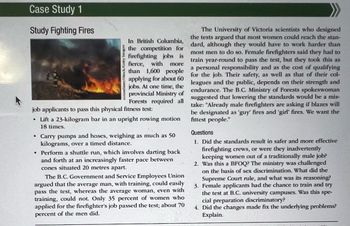
Practical Management Science
6th Edition
ISBN: 9781337406659
Author: WINSTON, Wayne L.
Publisher: Cengage,
expand_more
expand_more
format_list_bulleted
Question

Transcribed Image Text:Case Study 1
Study Fighting Fires
dina/Sack/Getty Images
In British Columbia,
the competition for
firefighting jobs is
fierce, with more
than 1,600 people
applying for about 60
jobs. At one time, the
provincial Ministry of
Forests required all
job applicants to pass this physical fitness test:
• Lift a 23-kilogram bar in an upright rowing motion
18 times.
⚫ Carry pumps and hoses, weighing as much as 50
kilograms, over a timed distance.
• Perform a shuttle run, which involves darting back
and forth at an increasingly faster pace between
cones situated 20 metres apart.
The B.C. Government and Service Employees Union
argued that the average man, with training, could easily
pass the test, whereas the average woman, even with
training, could not. Only 35 percent of women who
applied for the firefighter's job passed the test; about 70
percent of the men did.
The University of Victoria scientists who designed
the tests argued that most women could reach the stan-
dard, although they would have to work harder than
most men to do so. Female firefighters said they had to
train year-round to pass the test, but they took this as
a personal responsibility and as the cost of qualifying
for the job. Their safety, as well as that of their col-
leagues and the public, depends on their strength and
endurance. The B.C. Ministry of Forests spokeswoman
suggested that lowering the standards would be a mis-
take: "Already male firefighters are asking if blazes will
be designated as 'guy' fires and 'girl' fires. We want the
fittest people."
Questions
1. Did the standards result in safer and more effective
firefighting crews, or were they inadvertently
keeping women out of a traditionally male job?
2. Was this a BFOQ? The ministry was challenged
on the basis of sex discrimination. What did the
Supreme Court rule, and what was its reasoning?
3. Female applicants had the chance to train and try
the test at B.C. university campuses. Was this spe-
cial preparation discriminatory?
4. Did the changes made fix the underlying problems?
Explain.
Expert Solution
This question has been solved!
Explore an expertly crafted, step-by-step solution for a thorough understanding of key concepts.
Step by stepSolved in 2 steps

Knowledge Booster
Similar questions
- Chapter 29 Explain why healthcare providers are susceptible to fatigue.What element does the Joint Commission determine is the foundation of raising awareness and thereby reducing fatigue in the workplace? Describe the attributes of this element.arrow_forwardIdentify 4 "appropriateness factors" which the Labour Relations Board takes into account when assessing a certification application. (answer as soon as possible)arrow_forwardWhat does machine learning mean in employee training?arrow_forward
- 35. Patients have a right to: A) a pain management control plan. B) an assessment of their pain as long as there is sufficient staff to assess their level of pain. C) have their pain medications as often as they want. D) determine the strength of medications they wish to take.arrow_forwardDuring the first half of the year, 686 patients were admitted to the cardiovascular area unit. Of these 79 were readmissions. What percentage were readmitted?arrow_forwardWhat are the training, coaching, mentoring, and approaches that are appropriate for use in health and safety training programs?arrow_forward
- Question 1 The appearance of injury depends upon the: mechanism of the applied force, location of the actual injury, shape texture and pattern of the impacting object, and the physiological status of the individual. Question 1: True False Question 2 Knowing the mechanism of injury can determine method of care for the victims as well as corroborate or discredit accounts of an injury. Question 2: True False Question 3 Birthmarks such as Mongolian spots or port wine stains look deceptively like bruising. Question 3: True False Question 4 MATCH THE ITEM WITH THE APPROPRIATE DESCRIPTION Question 4: Crush injury Abrasions Contusions Penetration wounds Incisions Blunt force trauma Hematomas Gunshot wounds Lacerations Puncture wounds Through-and-through 1. occurs when an object comes in contact with a surface 2. caused by a clean, sharp-edged object…arrow_forwardClaudine Soosay recorded the following times assembling a watch: Observation No. 1 2 3 4 5 6 7 8 Performance rating is given as 95%. a) The average time of Claudine for the operation = Time (minutes) 0.11 0.09 0.11 0.09 0.15 0.10 0.09 0.10 Observation No. 9 10 11 12 13 14 15 16 minutes (round your response to three decimal places). Time (minutes) 0.11 0.09 0.11 0.10 0.11 0.12 0.14 0.10arrow_forwardwhy you think air traffic controller should not be retired earlyarrow_forward
arrow_back_ios
arrow_forward_ios
Recommended textbooks for you
 Practical Management ScienceOperations ManagementISBN:9781337406659Author:WINSTON, Wayne L.Publisher:Cengage,
Practical Management ScienceOperations ManagementISBN:9781337406659Author:WINSTON, Wayne L.Publisher:Cengage, Operations ManagementOperations ManagementISBN:9781259667473Author:William J StevensonPublisher:McGraw-Hill Education
Operations ManagementOperations ManagementISBN:9781259667473Author:William J StevensonPublisher:McGraw-Hill Education Operations and Supply Chain Management (Mcgraw-hi...Operations ManagementISBN:9781259666100Author:F. Robert Jacobs, Richard B ChasePublisher:McGraw-Hill Education
Operations and Supply Chain Management (Mcgraw-hi...Operations ManagementISBN:9781259666100Author:F. Robert Jacobs, Richard B ChasePublisher:McGraw-Hill Education
 Purchasing and Supply Chain ManagementOperations ManagementISBN:9781285869681Author:Robert M. Monczka, Robert B. Handfield, Larry C. Giunipero, James L. PattersonPublisher:Cengage Learning
Purchasing and Supply Chain ManagementOperations ManagementISBN:9781285869681Author:Robert M. Monczka, Robert B. Handfield, Larry C. Giunipero, James L. PattersonPublisher:Cengage Learning Production and Operations Analysis, Seventh Editi...Operations ManagementISBN:9781478623069Author:Steven Nahmias, Tava Lennon OlsenPublisher:Waveland Press, Inc.
Production and Operations Analysis, Seventh Editi...Operations ManagementISBN:9781478623069Author:Steven Nahmias, Tava Lennon OlsenPublisher:Waveland Press, Inc.

Practical Management Science
Operations Management
ISBN:9781337406659
Author:WINSTON, Wayne L.
Publisher:Cengage,

Operations Management
Operations Management
ISBN:9781259667473
Author:William J Stevenson
Publisher:McGraw-Hill Education

Operations and Supply Chain Management (Mcgraw-hi...
Operations Management
ISBN:9781259666100
Author:F. Robert Jacobs, Richard B Chase
Publisher:McGraw-Hill Education


Purchasing and Supply Chain Management
Operations Management
ISBN:9781285869681
Author:Robert M. Monczka, Robert B. Handfield, Larry C. Giunipero, James L. Patterson
Publisher:Cengage Learning

Production and Operations Analysis, Seventh Editi...
Operations Management
ISBN:9781478623069
Author:Steven Nahmias, Tava Lennon Olsen
Publisher:Waveland Press, Inc.